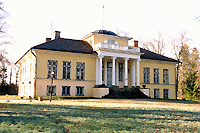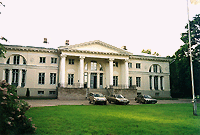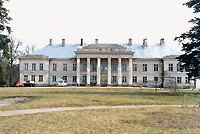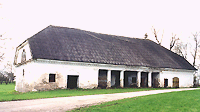 |
Previous part (previous style)
 High Classicism reached Estonia in around 1800-30, when
Baroque
lushness in architecture had in many cases been totally replaced by antique elements. This period was rather short in Estonia and all its forms did not root deeply here. For example, due to the Estonian climate and amount of snow, a high roof was often kept.
High Classicism reached Estonia in around 1800-30, when
Baroque
lushness in architecture had in many cases been totally replaced by antique elements. This period was rather short in Estonia and all its forms did not root deeply here. For example, due to the Estonian climate and amount of snow, a high roof was often kept.
The best examples of preserved High-Classicist manorial architecture in Estonia:
Saku,
Riisipere,
Kernu,
Kirna,
Kolga,
Raikküla,
Udriku,
Aaspere,
Hõreda,
 Pirgu,
Vohnja,
Uhtna,
Massu,
Härgla,
Räpina,
Penijõe,
Lihula,
Kasti,
Triigi (Harjumaa county),
Putkaste (in Hiiumaa island),
Kurisoo,
Tori (in Järva county),
Orina (later partly rebult)
gate house of Võhmuta manor,
granary of Käravete manor.
Pirgu,
Vohnja,
Uhtna,
Massu,
Härgla,
Räpina,
Penijõe,
Lihula,
Kasti,
Triigi (Harjumaa county),
Putkaste (in Hiiumaa island),
Kurisoo,
Tori (in Järva county),
Orina (later partly rebult)
gate house of Võhmuta manor,
granary of Käravete manor.
The best preserved examples of wooden Classicist manor houses:
Einmanni,
Räägu,
Riguldi,
Kehra (partly changed),
and
Uue-Varbla.

Preserved examples of Late Classicist manor houses:
Mädapea,
Ontika,
Suure-Kõpu,
Kuremaa,
Sauga (in ruins),
Palivere,
Vana-Võidu (two last ones later rebuilt into 2-storey houses)
Paju,
chapel of Järvakandi manor.
And there are also some Post-Classicist (build during the 2nd half of 19th century) manor houses in Estonia:
Pagari,
Järlepa (reconstructed in Classicist form after the fire in 1905) and
Raadi manor gate buliding.

Next part (next style)
|
 |









